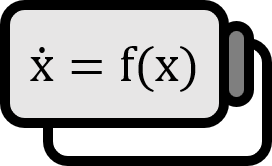数学における質量作用の法則
説明 1
数理的モデリングでは、質量作用の法則は、名前が示す通り、日常的に使われる。たとえば、二つの物質$A$と$B$が反応して$k$の反応速度で$C$を生成すると考えてみよう。 $$ A + B \overset{k}{\to} C $$ 質量作用の法則によると、$C$の増加量はその瞬間瞬間に$A$と$B$に比例するべきだ。これを微分方程式で表すと、 $$ {{ d [C] } \over { dt }} = k [A] [B] $$ のように表現できる。$A$と$B$が多ければ多いほど反応は多く起きるが、そのどちらかがあまりにも少ないとその量も減少するのが自然に反映されている。
$$ A + B \overset{k_{+}}{\to} C \\ A + B \underset{k_{-}}{\leftarrow} C $$ 今度は、$k_{+}$が$k_{-}$に分解する反応の逆反応を考えてみよう。 $$ {{ d [C] } \over { dt }} = - k_{-} [C] + k_{+} [A] [B] $$ このようにシステムが微分方程式で表現されれば、平衡点を簡単に計算できる。系が熱力学的平衡にある時、$C$の量は変わらないように見えるので、変化量${{ d [C] } \over { dt }}$を$0$として式を整理してみると、 $$ {{ k_{-} } \over { k_{+} }} = {{ [A][B] } \over { [C] }} $$ すなわち$A,B,C$の量は上の式を満たす時、これ以上変わらなくなる。平衡点は正確に動力学的(数学的)固定点であり、この議論から、物理的または生化学的現象を描写するシステムに対して動力学のツールを適用できることを確認した。
Generalization 2
Although it’s called the “Law of Mass Action” and the description indeed refers to chemical reactions, from the standpoint of mathematical modeling, “concentration” or “amount” can be abstractly understood. For example, below is a very basic system shown for the SIR model.
$$ \begin{align*} {{d S} \over {d t}} =& - {{ \beta } \over { N }} I S \\ {{d I} \over {d t}} =& {{ \beta } \over { N }} S I - \mu I \\ {{d R} \over {d t}} =& \mu I \end{align*} $$
In this system, the number of entities that can be infected, $S$, and the number of infected, $I$, are seen to react with the infection rate $\beta$.
